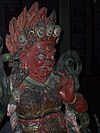Central Asia
From Wikipedia, the free encyclopedia
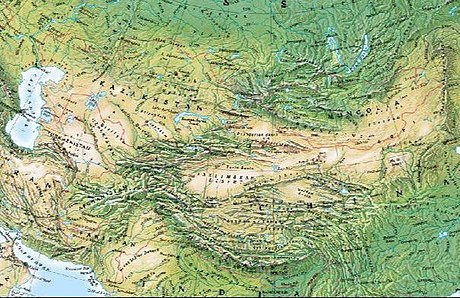
Central Asia is a region of Asia from the Caspian Sea in the west to central China in the east, and from southern Russia in the north to northern India in the south. It is also sometimes known as Middle Asia or Inner Asia, and is within the scope of the wider Eurasian continent. Various definitions of its exact composition exist and no one definition is universally accepted. Despite this uncertainty in defining borders, it does have some important overall characteristics. For one, Central Asia has historically been closely tied to its nomadic peoples and the Silk Road.[1] As a result, it has acted as a crossroads for the movement of people, goods, and ideas between Europe, Western Asia, South Asia, and East Asia.[2]
In modern context, Central Asia consists of the five former Soviet republics of Kazakhstan, Kyrgyzstan, Tajikistan, Turkmenistan and Uzbekistan. Other areas are often included such as Afghanistan, northeastern Iran and western parts of the People's Republic of China such as Xinjiang. Mongolia, Kashmir northern Pakistan, southwestern and middle China such as Tibet, Qinghai, Gansu and Inner Mongolia, and southern parts of Siberia may also be included in Central Asia.
During pre-Islamic and early Islamic times, Central Asia was a predominantely Iranian[3][4] region. Among the ancient sedentary Iranian peoples, the Sogdian and Chorasmians played an important role. Ancient Iranian culture also has an important role in the history of some parts of the region and Tajiks, Pamiris and other Iranian groups still are present in the region. After expansion by Turkic peoples, central Asia became also the homeland for many Turkic peoples, including the Uzbeks, Kazakhs, Kyrgyz and Uyghurs, and Central Asia is sometimes referred to as Turkestan.
Contents |
[edit] Definitions
The idea of Central Asia as a distinct region of the world was introduced in 1843 by the geographer Alexander von Humboldt. The borders of Central Asia are subject to multiple definitions. Many text books still refer to this area as Turkestan, which was the name used prior to Stalin's rule.
The most limited definition was the official one of the Soviet Union that defined the "Middle Asia" as consisting solely of Uzbekistan, Turkmenistan, Tajikistan, and Kyrgyzstan, but did not include Kazakhstan, Pakistan, Afghanistan and Mongolia. This definition was also often used outside the USSR in this period. However, the Russian language has two distinct terms: Средняя Азия (Srednyaya Aziya or "Middle Asia", the narrower definition which includes only those traditionally non-Slavic, "Central Asian" lands that were incorporated within those borders of historical Russia) and Центральная Азия (Tsentral'naya Aziya or "Central Asia", the wider definition which includes "Central Asian" lands that have never been part of historical Russia). However, there lacks a meaningful distinction between the two in the English language; and so "Central Asia" is used for both Russian usages, thus creating some confusion.
Soon after independence, the leaders of the five former Soviet Central Asian Republics met in Tashkent and declared that the definition of Central Asia should include Kazakhstan as well as the original four included by the Soviets. Since then, this has become the most common definition of Central Asia.
The UNESCO general history of Central Asia, written just before the collapse of the USSR, defines the region based on climate and uses far larger borders. According to it, Central Asia includes Mongolia, Tibet, northern Jammu & Kashmir, and, northeast Iran (Golestan, North Khorasan, and Razavi provinces), Afghanistan, northern Pakistan (Punjab, Azad Jammu and Kashmir, Northern Areas, and N.W.F.P. provinces), central-east Russia south of the Taiga, and the former Central Asian Soviet Republics (the five "Stans" of the former Soviet Union). An alternative method is to define the region based on ethnicity, and in particular, areas populated by Eastern Turkic, Eastern Iranian, or Mongolian peoples. These areas include Xinjiang Uyghur Autonomous Region, the Turkic regions of southern Siberia, the five republics, and Afghan Turkestan, northern Pakistan and Afghans. The Tibetans are also included. Insofar, the mentioned peoples are considered the "indigenous" peoples of the vast region.
There are several places that claim to be the geographic center of Asia, for example Kyzyl, the capital of the Tuvan Republic in the Russian Federation, and a village 200 miles (320 km) North of Urumqi, Xinjiang, China[5].
[edit] Geography

Central Asia is an extremely large region of varied geography, including high passes and mountains (Tian Shan), vast deserts (Kara Kum, Kyzyl Kum, Taklamakan), and especially treeless, grassy steppes. The vast steppe areas of Central Asia are considered together with the steppes of Eastern Europe as a homogenous geographical zone known as the Euro-Asian Steppe.
Much of the land of Central Asia is too dry or too rugged for farming. The Gobi desert extends from the foot of the Pamirs, 77° east, to the Great Khingan (Da Hinggan) Mountains, 116°–118° east.
Central Asia has the following geographic extremes:
- The world's northernmost desert (sand dunes), at Buurug Deliin Els, Mongolia, 50°18' north.
- The Northern Hemisphere's southernmost permafrost, at Erdenetsogt sum, Mongolia, 46°17' north.
- The world's shortest distance between non-frozen desert and permafrost: 770 km (440 mi).
A majority of the people earn a living by herding livestock. Industrial activity centers in the region's cities.
Major rivers of the region include the Amu Darya, the Syr Darya and the Hari River. Major bodies of water include the Aral Sea and Lake Balkhash, both of which are part of the huge west/central Asian endorheic basin that also includes the Caspian Sea. Both of these bodies of water have shrunk significantly in recent decades due to diversion of water from rivers that feed them for irrigation and industrial purposes. Water is an extremely valuable resource in arid Central Asia, and can lead to rather significant international disputes.
[edit] Climate
Since Central Asia is not buffered by a large body of water, temperature fluctuations are more severe.
According to the Köppen climate classification system, Central Asia is part of the Palearctic ecozone. The largest biome in Central Asia is the Temperate grasslands, savannas, and shrublands biome. Central Asia also contains the Montane grasslands and shrublands, Deserts and xeric shrublands and Temperate coniferous forests biomes.
[edit] History
The history of Central Asia is defined by the area's climate and geography. The aridness of the region made agriculture difficult and its distance from the sea cut it off from much trade. Thus few major cities developed in the region, instead the area was for millennia dominated by the nomadic horse peoples of the steppe.
Relations between the steppe nomads and the settled people in and around Central Asia were long marked by conflict. The nomadic lifestyle was well suited to warfare and the steppe horse riders became some of the most militarily potent peoples in the world, only limited by their lack of internal unity. Any internal unity that was achieved, was most probably due to the influence of the Silk Road, which traveled along Central Asia. Periodically great leaders or changing conditions would organize several tribes into one force, and create an almost unstoppable power. These included the Hun invasion of Europe, the Wu Hu attacks on China and most notably the Mongol conquest of much of Eurasia.[6]
The dominance of the nomads ended in the 16th century, as firearms allowed settled peoples to gain control of the region. Russia, China, and other powers expanded into the region and had captured the bulk of Central Asia by the end of the nineteenth century. After the Russian Revolution the Central Asian regions were incorporated into the Soviet Union. Mongolia remained independent but became a Soviet satellite state. The Soviet areas of Central Asia saw much industrialization and construction of infrastructure, but also the suppression of local cultures, hundreds of thousands of deaths from failed collectivization programs, and a lasting legacy of ethnic tensions and environmental problems. Soviet authorities deported millions of people, including entire nationalities,[7] from western areas of the USSR to Central Asia and Siberia.[8]
With the collapse of the Soviet Union five countries gained independence. In nearly all the new states former Communist Party officials retained power as local strongmen. None of the new republics could be considered functional democracies in the early days of independence, although it appears Kyrgyzstan, Kazakhstan and Mongolia have made great strides. Other parts of Central Asia remain part of China or Russia.
[edit] Culture
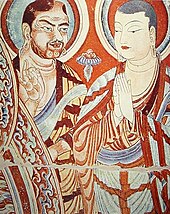
[edit] Religions
Islam is the religion most common in the Central Asian Republics, Afghanistan, Xinjiang and the peripheral western regions, such as Bashkiria. Most Central Asian Muslims are Sunni, although there are sizeable Shia minorities in Afghanistan. Hinduism is the religion most prevalent in northwest India although there is a considerable presence of Islam. There are also sizeable minorities of Hindus in Pakistan and Afghanistan. Tibetan Buddhism is most common in Tibet, Mongolia, and the southern Russian regions of Siberia, where Shamanism is also popular. Increasing Han Chinese migration westward since the establishment of the PRC has brought Confucianism and other beliefs into the region. Nestorianism was the form of Christianity most practiced in the region in previous centuries, but now the largest denomination is the Russian Orthodox Church, with many members in Kazakhstan. The Bukharian Jews were once a sizable community in Uzbekistan and Tajikistan, but nearly all have emigrated since the Collapse of the Soviet Union and the revival of Islam in the region.
[edit] Arts
At the crossroads of Asia, shamanist practices live alongside Buddhism. Thus Yama, Lord of Death, was revered in Tibet as a spiritual guardian and judge. Mongolian Buddhism in particular influenced Tibetan Buddhism. The Qianlong Emperor of China in the 18th century was Tibetan Buddhist, and would sometimes travel from Beijing to other cities for personal religious worship.
Note the human skulls and severed heads that festoon Yama's crown and necklace, which give some concept of the size that Yama was expected to be when one faced him at one's death. This particular Dharmapala is painted wood, four feet high in total.
Central Asia also has an indigenous form of improvisational oral poetry which is over 1000 years old. It is principally practiced in Kyrgyzstan and Kazakhstan by akyns, lyrical improvisationists. They will engage in lyrical battles, the aitysh or the alym sabak. The tradition arose out of early bardic oral historians. They are usually accompanied by a stringed instrument—in Kyrgyzstan, a three-stringed komuz and in Kazakhstan a similar two-stringed instrument. Some also learn to sing the Manas, Kyrgyzstan's epic poem (those who learn the Manas exclusively but do not improvise are called manaschis). During Soviet rule, akyn performance was co-opted by the authorities and subsequently declined in popularity. With the fall of the Soviet Union it has enjoyed a resurgence, although akyns still do use their art to campaign for political candidates. A 2005 Washington Post article proposed a similarity between the improvisational art of akyns and modern freestyle rap performed in the West.[9]
[edit] Demographics
By the most inclusive definition, more than 80 million people live in Central Asia, about 2% of Asia's total population. Of the regions of Asia, only North Asia has fewer people. It has a population density of 9 people per km², vastly less than the 80.5 people per km² of the continent as a whole.
[edit] Languages
The languages of the majority of the inhabitants of the former Soviet Central Asian Republics come from the Turkic language group.[10] Turkmen, closely related to Turkish (they are both members of the Oghuz group of Turkic), is mainly spoken in Turkmenistan and into Afghanistan, Pakistan, Iran and Turkey. Kazakh, Kyrgyz and Tatar are related languages of the Kypchak group of Turkic languages, and are spoken throughout Kazakhstan, Kyrgyzstan and Tajikistan, and into Afghanistan, Xinjiang and Qinghai. Uzbek and Uyghur are spoken in Uzbekistan, Tajikistan and Xinjiang.
Russian, as well as being spoken by around six million ethnic Russians and Ukrainians of Central Asia[11], is a lingua franca throughout the former Soviet Central Asian Republics. Mandarin Chinese has an equally dominant presence in Inner Mongolia, Qinghai and Xinjiang.
The Turkic languages belong to the much larger, but controversial Altaic language family, which includes Mongolian. Mongolian is spoken throughout the region of Mongolia and into Inner Mongolia, Qinghai and Xinjiang.
East Iranian languages were once spoken throughout Central Asia, but the once prominent Sogdian, Khwarezmian, Bactrian and Scythian languages are now extinct. However, the East Iranian Pashto is still spoken in Afghanistan and northwestern Pakistan, and other minor East Iranian languages, such as Shughni, Munji, Ishkashimi, Sarikoli, Wakhi, Yaghnobi and Ossetian are also spoken in various places in Central Asia. Varieties of Persian are also spoken in the region, locally known as Darī (in Afghanistan), Tojikī (by Tajiks in Tajikistan), and Bukhori (by the Bukharan Jews in Bukhara).
The Tibetan language is spoken by around six million people across the Tibetan Plateau and into Qinghai and Sichuan.
Tocharian, an Indo-European language, was once spoken in Xinjiang and parts of Afghanistan, but is now extinct.
|
|||||||||||
[edit] Geostrategy
Central Asia has long been a strategic location merely because of its proximity to several great powers on the Eurasian landmass. The region itself never held a dominant stationary population, nor was able to make use of natural resources. Thus it has rarely throughout history become the seat of power for an empire or influential state. Central Asia has been divided, redivided, conquered out of existence, and fragmented time and time again. Central Asia has served more as the battleground for outside powers, than as a power in its own right.
Central Asia had both the advantage and disadvantage of a central location between four historical seats of power. From its central location, it has access to trade routes to and from all the regional powers. On the other hand, it has been continuously vulnerable to attack from all sides throughout its history, resulting in political fragmentation or outright power vacuum, as it is successively dominated.

- To the North, the steppe allowed for rapid mobility, first for nomadic horseback warriors like the Huns and Mongols, and later for Russian traders, eventually supported by railroads. As the Russian empire expanded to the East, it would also push down into Central Asia towards the sea, in a search for warm water ports. The Soviet bloc would reinforce dominance from the North, and attempt to project power as far south as Afghanistan.
- To the East, the demographic and cultural weight of Chinese empires continually pushed outward into Central Asia. Manchu Qing dynasty would conquer Uyghurstan/East Turkistan and Tibet. As part of the Sino-Soviet bloc, China would keep Tibet. However, with the Sino-Soviet split, China would project power into Central Asia, most notably in the case of Afghanistan, to counter Russian dominance of the region.
- To the Southeast, the demographic and cultural influence of India was felt in Central Asia, notably in Tibet, the Hindu Kush, and slightly beyond. Several historical Indian dynasties, especially those seated along the Indus river would expand into Central Asia. India's ability to project power into Central Asia has been limited due to the mountain ranges in Pakistan, and the cultural differences between Hindu India, and what would become a mostly Muslim Central Asia.
- To the Southwest, Western Asian powers have expanded into the Southern areas of Central Asia (usually, Uzbekistan, Afghanistan, and Pakistan). Several Persian empires would conquer and reconquer parts of Central Asia; Alexander the Great's Hellenic empire would extend into Central Asia; two Islamic empires would exert substantial influence throughout the region; and the modern state of Iran has projected influence throughout the region as well.
In the post-Cold War era, Central Asia is an ethnic cauldron, prone to instability and conflicts, without a sense of national identity, but rather a mess of historical cultural influences, tribal and clan loyalties, and religious fervor. Projecting influence into the area is no longer just Russia, but also Turkey, Iran, China, Pakistan, India and the United States:
- Russia continues to dominate political decision-making throughout the former SSRs, although as these countries shed their post-Soviet authoritarian systems, Russia's influence is slowly waning.
- China, already controlling Xinjiang and Tibet, projects significant power in the region, especially in energy/oil politics (for example, through the Shanghai Cooperation Organization).
- India, as a nuclear-armed rising power, exercises some influence in the region, especially in Tibet with which it has cultural affinities. India is also perceived as a potential counterweight to China's regional power. The Indian Air Force operates the Farkhor Air Base in Tajikistan.
- Turkey exerts considerable influence in the region on account of its ethnic and linguistic ties with the Turkic peoples of Central Asia and its involvement in the Baku-Tbilisi-Ceyhan oil pipeline. Political and economic relations are growing rapidly (e.g. Turkey recently eliminated visa requirements for citizens of the Central Asian Turkic republics).
- Iran, the seat of historical empires which controlled parts of Central Asia, has historical and cultural links to the region, and is vying to construct an oil pipeline from the Caspian Sea to the Persian Gulf.
- Pakistan, a large and nuclear-armed state, helped to sustain Taliban rule in Afghanistan, and is capable of exercising some influence. For some Central Asian nations, the shortest route to the ocean lies through Pakistan. Pakistan seeks Natural Gas from Central Asia, and supports the development of pipelines from its countries.
- And the United States with its military involvement in the region, and oil diplomacy, is also significantly involved in the region's politics.
[edit] War on Terror
In the context of the United States' War on Terror, Central Asia has once again become the center of geostrategic calculations. Pakistan's status has been upgraded by the U.S.-government to Major non-NATO ally because of its central role in serving as a staging point for the invasion of Afghanistan, providing intelligence on Al-Qaeda operations in the region, and leading the hunt on Osama bin Laden, believed to still be in the region. Afghanistan, which had served as a haven and source of support for Al-Qaeda, under the protection of Mullah Omar and the Taliban, was the target of a U.S. invasion in 2001, and ongoing reconstruction and drug-eradication efforts. U.S. military bases have also been established in Uzbekistan and Kyrgyzstan, causing both Russia and the People's Republic of China to voice their concern over a permanent U.S. military presence in the region.
Western observers and governments have claimed that Russia, China and the former Soviet republics have taken advantage of the War on Terror to increase oppression of certain ethnic groups, including minority separatist movements, as well as some religious groups. Washington, which considers Russia and China as strategic partners in the War on Terror, has largely turned a blind eye to these claims.
[edit] Major cultural and economic centres
| City | Country | Population | Image | Information |
|---|---|---|---|---|
| Tashkent | 2,180,000 (2008) |
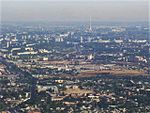 |
The capital of Uzbekistan and the biggest city in Uzbekistan. | |
| Ashgabat | 695,300 (2001) |
 |
The capital of Turkmenistan and the biggest city in Turkmenistan. | |
| Mashhad | 2,427,316 (2006) |
 |
The second largest city in Iran and one of the holiest cities in the Shia world. | |
| Mazar-e Sharif | 300,600 (2006) |
 |
The fourth largest city in Afghanistan and capital of Balkh province and is linked by roads to Kabul in the south-east, Herat to the west and Uzbekistan to the north. | |
| Samarkand | 596,300 (2008) |
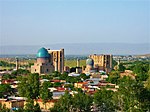 |
The second-largest city in Uzbekistan and the capital of Samarqand Province. The city is most noted for its central position on the Silk Road between China and the West, and for being an Islamic centre for scholarly study. | |
| Bishkek | 1,250,000 (2007) |
 |
The capital and the largest city of Kyrgyzstan. Bishkek is also the administrative center of Chuy Province which surrounds the city, even though the city itself is not part of the province but rather a province-level unit of Kyrgyzstan. | |
| Tous | N/A |  |
An ancient city in the Iranian province of Razavi Khorasan. | |
| Astana | 700,000 (2009) |
 |
The capital and second largest city in Kazakhstan. | |
| Dushanbe | 679,400 (2008) |
 |
The capital and largest city of Tajikistan. Dushanbe means "Monday" in Tajik,[12] and the name reflects the fact that the city grew on the site of a village that originally was a popular Monday marketplace. | |
| Bukhara | 237,900 (1999) |
 |
The nation's fifth-largest city and the capital of the Bukhara Province of Uzbekistan. | |
| Almaty | 1,420,747 (2009) |
 |
It was the capital of Kazakhstan (and its predecessor, the Kazakh SSR) from 1929 to 1998. Despite losing its status as the capital, Almaty remains the major commercial center of Kazakhstan. | |
| Nishapur | 270,972 (2006) |
 |
The city is located in the Razavi Khorasan province in northeastern Iran, situated in a fertile plain at the foot of the Binalud Mountains, near the regional capital of Mashhad. |
[edit] See also
- Agriculture in Central Asia
- Central Asian studies
- Central Asian Union
- ECO
- Eurasian nomads
- Euro-Asian Steppe
- Great Game (the rivalry between the British Empire and Tsarist Russia in the 19th century for control of Central Asia)
- Hindutash
- Khotan
- Music of Central Asia
- Soviet Central Asia (1924-1991)
- Survey of India
- Turkistan
- Afghan Turkestan
- University of Central Asia
- Ancient India and Central Asia
[edit] Citations
- ^ Steppe Nomads and Central Asia
- ^ Travelers on the Silk Road
- ^ Encyclopædia Iranica, "CENTRAL ASIA: The Islamic period up to the mongols", C. Edmund Bosworth: "In early Islamic times Persians tended to identify all the lands to the northeast of Khorasan and lying beyond the Oxus with the region of Turan, which in the Shahnama of Ferdowsi is regarded as the land allotted to Fereydun's son Tur. The denizens of Turan were held to include the Turks, in the first four centuries of Islam essentially those nomadizing beyond the Jaxartes, and behind them the Chinese (see Kowalski; Minorsky, "Turan"). Turan thus became both an ethnic and a geographical term, but always containing ambiguities and contradictions, arising from the fact that all through Islamic times the lands immediately beyond the Oxus and along its lower reaches were the homes not of Turks but of Iranian peoples, such as the Sogdians and Khwarezmians."
- ^ C.E. Bosworth, "The Appearance of the Arabs in Central Asia under the Umayyads and the establishment of Islam", in History of Civilizations of Central Asia, Vol. IV: The Age of Achievement: AD 750 to the End of the Fifteenth Century, Part One: The Historical, Social and Economic Setting, edited by M. S. Asimov and C. E. Bosworth. Multiple History Series. Paris: UNESCO Publishing, 1998. excerpt from page 23: "Central Asia in the early seventh century, was ethnically, still largely an Iranian land whose people used various Middle Iranian languages.
- ^ 43°40'52"N 87°19'52"E Degree Confluence Project.
- ^ A Land Conquered by the Mongols
- ^ Deported Nationalities
- ^ Anne Applebaum -- Gulag: A History Intro
- ^ «In Central Asia, a Revival of an Ancient Form of Rap - Art of Ad-Libbing Oral History Draws New Devotees in Post-Communist Era» by Peter Finn, Washington Post Foreign Service, Sunday, March 6, 2005, p. A20.
- ^ Ethnographic maps
- ^ Robert Greenall, Russians left behind in Central Asia, BBC News, 23 November 2005.
- ^ D. Saimaddinov, S. D. Kholmatova, and S. Karimov, Tajik-Russian Dictionary, Academy of Sciences of the Republic of Tajikistan, Rudaki Institute of Language and Literature, Scientific Center for Persian-Tajik Culture, Dushanbe, 2006.
[edit] General references
- Dani, A.H. and V.M. Masson eds. UNESCO History of Civilizations of Central Asia. Paris: UNESCO, 1992.
- Mandelbaum, Michael. ed. Central Asia and the World: Kazakhstan, Uzbekistan, Tajikistan, Kyrgyzstan, and Turkmenistan New York: Council on Foreign Relations Press, 1994.
- Olcott, Martha Brill. Central Asia's New States: Independence, Foreign policy, and Regional security. Washington, D.C.: United States Institute of Peace Press, 1996.
- Soucek, Svatopluk. A History of Inner Asia. Cambridge: Cambridge University Press, 2000.
- Marcinkowski, M. Ismail. Persian Historiography and Geography: Bertold Spuler on Major Works Produced in Iran, the Caucasus, Central Asia, Pakistan and Early Ottoman Turkey, Singapore: Pustaka Nasional, 2003.
- Rall, Ted. "Silk Road to Ruin: Is Central Asia the New Middle East?" New York: NBM Publishing, 2006.
- Stone, L. A' 'The International Politics of Central Eurasia', (272 pp). Central Eurasian Studies On Line: Accessible via the Web Page of the International Eurasian Institute for Economic and Political Research: http://www.iicas.org/forumen.htm
- Weston, David. Teaching about Inner Asia, Bloomington, Indiana: ERIC Clearinghouse for Social Studies, 1989.
[edit] External links
- Central Asia Health Review
- University of Cambridge Central Asia Forum
- Central Asia Gateway
- Central Eurasian Studies World Wide
- National Geographic.com - Nat Geo Music: Central Asian Classical Music page
- National Geographic.com - Nat Geo Music: Central Asian Bardic Music page
- Publications on the history of Central Asia Prior to 1917
- Policymakers' Guide to Central Asia
- University of Central Asia
- Discovery Central Asia magazine: Publications on the travel, history and culture of Central Asia
- New Europe News Extensive news coverage and analysis of Central Asia.
- Where West Meets East: The Complex mtDNA Landscape of the Southwest and Central Asian Corridor
- Texas Tech University, full-text examples of Central Asian literature
- [1] The International Politics of Central Eurasia], (272 pp). Central Eurasian Studies On Line: The International Eurasian Institute for Economic and Political Research, 2001.
- Research Institute for Inner Asian Studies (RIFIAS) Library Online Catalog Text Collection is one of North America's premier resources for teaching and research in the history, languages, literatures, geography, religions, and cultures of Inner Asia and is located at Indiana University
- University of Turin-Observatory on Central Asia
- The Library: Central on politics, universities, culture, languages, etc.
|
|||||
|
|||||||||||||||||||||||||||||||||




